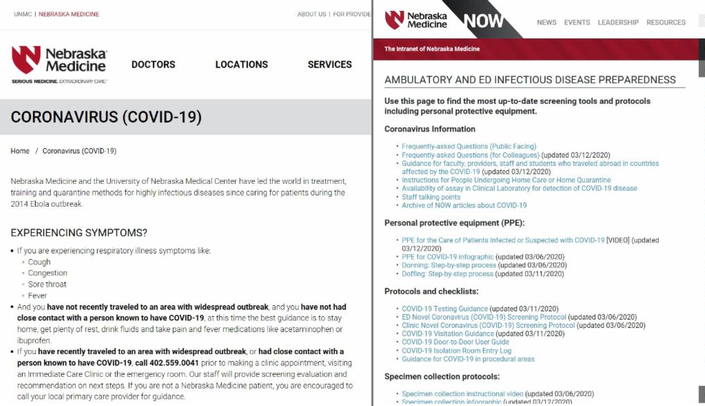Emergency Management (EM) uses an “all hazards approach” to all incidents that occur by targeting capacities and capabilities that are critical needs. A core component of the EM program is a biological pandemic preparedness plan that focuses on surges that could quickly disrupt the nation and community’s infrastructure by inflicting significant damage to our health care, economic, and government/political systems. Shelly Schwedhelm, Executive Director of Emergency Management and Clinical Operations at the Global Center for Health Security, led the planning and preparation efforts to poise Nebraska Medicine to be ready for the anticipated surge of COVID-19 patients. She is currently leading communication and coordination efforts throughout the state and HHS’s Region VII (Kansas, Missouri, Iowa, and Nebraska).
The UNMC/Nebraska Medicine team has had a plan in place to battle pandemics since early 2000—putting the plan to the test in 2009 when faced with the H1N1 pandemic. Since then, the team has updated the plan multiple times to address varying pathogens of concern as they arise. Nebraska Medicine established a pandemic planning committee to evaluate the current situation and revise its pandemic plan accordingly. The committee is broken into work groups that convene to review specifics of the pathogen of concern and to create new assumptions. Pandemic planning work groups include the following areas of expertise:
- Triage and Crisis Standards of Care
- Infection Prevention/Control & Medical Countermeasures
- Support Services
- Behavioral Health
- Communications
- Education
- Research
These teams meet weekly to report their results to the entire pandemic planning committee and then collaborate with each other’s directives. “The best part of having a plan is you have a lot of smart people coming together to innovate and who value the importance of protecting our patients, each other, and our organization,” Shelly noted, “We have refreshed our assumptions with the national data modeling for COVID-19 provided by Dr. James Lawler. We then assumed the data points for Nebraska and subsequently our primary service area and market share to understand what the demands would be for outpatient care, inpatient surge, ICU demand, ventilators, etc. This framework then gave way to strategies and interventions that could be implemented to accommodate these demands in patient surge.
Once assumptions are made about the effects of the virus, pandemic planning committee strives to mitigate those assumptions. Some well-known COVID-19 assumptions include: The U.S. will not have a vaccine for a year, human-to-human transmission spreads rapidly, infection in a localized area can last six to eight weeks or even longer, there is no pre-existing immunity to the virus, severity of infection is dependent on age and comorbidities, and elderly and those with chronic comorbidities appear at a higher risk of severe or fatal infections. “A lot of assumptions can be mitigated through communities doing their part in collaboration with government leaders to ‘flatten the curve,’” Shelly noted. The term ‘flattening the curve’ refers to using non-pharmaceutical interventions (NPI) to prevent infection and spread of the virus. NPI for COVID-19 include the following:
- If you are ill, isolate. Avoid contact with others.
- Wash your hands properly.
- Avoid touching your face.
- Do not attend large group gatherings.
- Maintain 6 foot distance from others.
- Work from home, if possible.
Having a strong pandemic plan is essential to building resilience in the healthcare environment. Without a plan, ensuing chaos may create an unsustainable demand on the community’s healthcare system—but at UNMC/Nebraska Medicine, the staff are well-prepared to face and fulfill those needs with confidence. “Many individuals from the organization have taken on new duties and are working hard to achieve enhanced readiness by the time patient surge begins,” Shelly notes, “We want to be one of those communities that can state we ’kept Nebraska flat.’”
